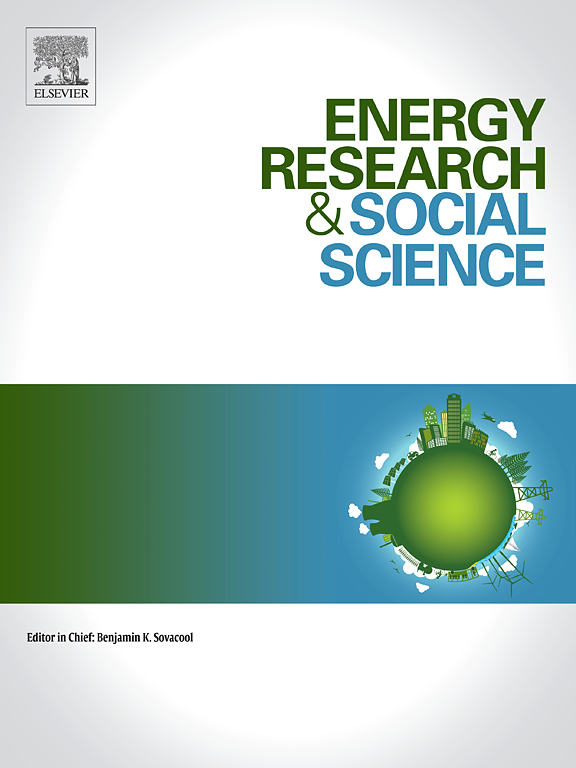光靠太阳是不够的:亚利桑那州和阿尔及利亚缓慢的太阳能过渡
IF 6.9
2区 经济学
Q1 ENVIRONMENTAL STUDIES
引用次数: 0
摘要
随着对电力需求的不断增长,对环境的担忧也随之增加,我们正在寻找同时解决这两个问题的方法。尽管太阳能开发可以同时满足这两个挑战,但其巨大潜力在很大程度上仍未得到开发。这是为什么呢?为了解决这个问题,我们考察了两个地方的太阳能发展情况,这两个地方本应成为世界太阳能转型的先行者:亚利桑那州和阿尔及利亚。尽管太阳能资产几乎完全相同,但这两个地方在更积极地向太阳能未来过渡方面却同样缓慢。尽管在规模和历史上存在明显差异,但这两个地方也有一些共同特点,例如高增长率、相似的人口聚集模式、广阔的开放空间以及可比的离网土著居民比例。我们的评估分为四个部分:(1) 太阳能的诱惑力和接受度,(2) 亚利桑那州与阿尔及利亚的比较,(3) 太阳能发展现状,(4) 目前采用太阳能的障碍。我们的研究结果表明,仅靠资源丰富无法推动太阳能的大规模应用。这项研究强调了解决更广泛的社会经济、政治和基础设施因素的智慧,这些因素会导致向太阳能的有意义的过渡。研究结果为决策者和利益相关者提供了重要的见解,帮助他们加快太阳能的应用,创造更加可持续的能源未来。本文章由计算机程序翻译,如有差异,请以英文原文为准。
The sun is not enough: The slow solar transition in Arizona and Algeria
As environmental worries rise with the growing demand for electricity, we are searching for a way to address both problems simultaneously. Although solar energy development can satisfy both challenges at the same time, its vast potential remains largely untapped. Why is that? We address this question by examining solar development in two places that should be pace-setters of a solar transition in their respective parts of the world: Arizona and Algeria. Despite virtually identical solar assets, both places have been equally slow to transition more enthusiastically to a solar energy future. Even with their obvious differences in scale and history, they have several characteristics in common, such as high growth rates, similar population clustering patterns, extensive open spaces, and comparable percentages of off-grid Indigenous residents. We divide our appraisal into four parts: (1) The allure and acceptance of solar energy, (2) The Arizona/Algeria comparison, (3) The present status of solar development, and (4) The current barriers to solar adoption. Our findings underscore resource abundance alone cannot drive large-scale solar energy adoption. This research highlights the wisdom of addressing broader socioeconomic, political, and infrastructural factors that lead to a meaningful transition to solar energy. The results offer critical insights for policymakers and stakeholders seeking to accelerate solar energy deployment and create a more sustainable energy future.
求助全文
通过发布文献求助,成功后即可免费获取论文全文。
去求助
来源期刊

Energy Research & Social Science
ENVIRONMENTAL STUDIES-
CiteScore
14.00
自引率
16.40%
发文量
441
审稿时长
55 days
期刊介绍:
Energy Research & Social Science (ERSS) is a peer-reviewed international journal that publishes original research and review articles examining the relationship between energy systems and society. ERSS covers a range of topics revolving around the intersection of energy technologies, fuels, and resources on one side and social processes and influences - including communities of energy users, people affected by energy production, social institutions, customs, traditions, behaviors, and policies - on the other. Put another way, ERSS investigates the social system surrounding energy technology and hardware. ERSS is relevant for energy practitioners, researchers interested in the social aspects of energy production or use, and policymakers.
Energy Research & Social Science (ERSS) provides an interdisciplinary forum to discuss how social and technical issues related to energy production and consumption interact. Energy production, distribution, and consumption all have both technical and human components, and the latter involves the human causes and consequences of energy-related activities and processes as well as social structures that shape how people interact with energy systems. Energy analysis, therefore, needs to look beyond the dimensions of technology and economics to include these social and human elements.
 求助内容:
求助内容: 应助结果提醒方式:
应助结果提醒方式:


